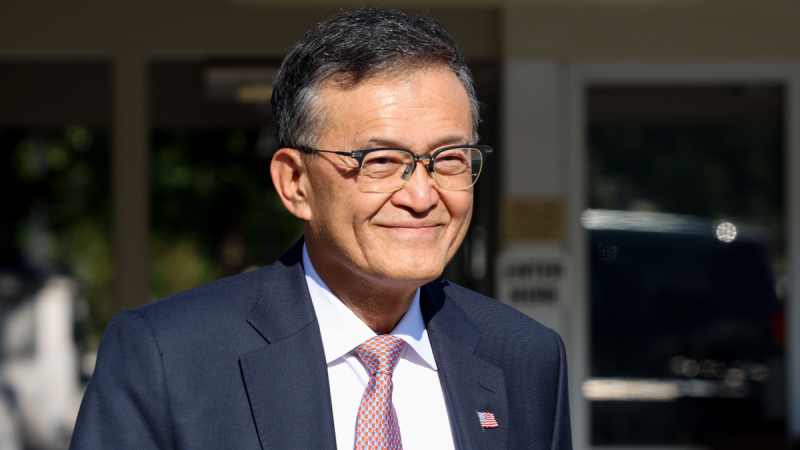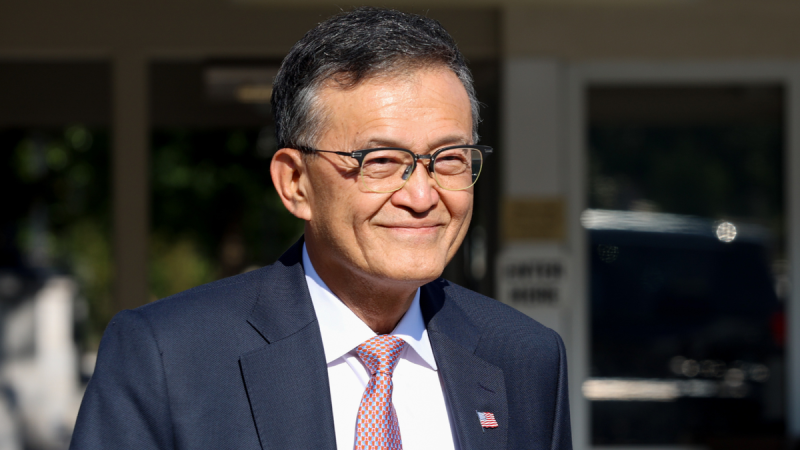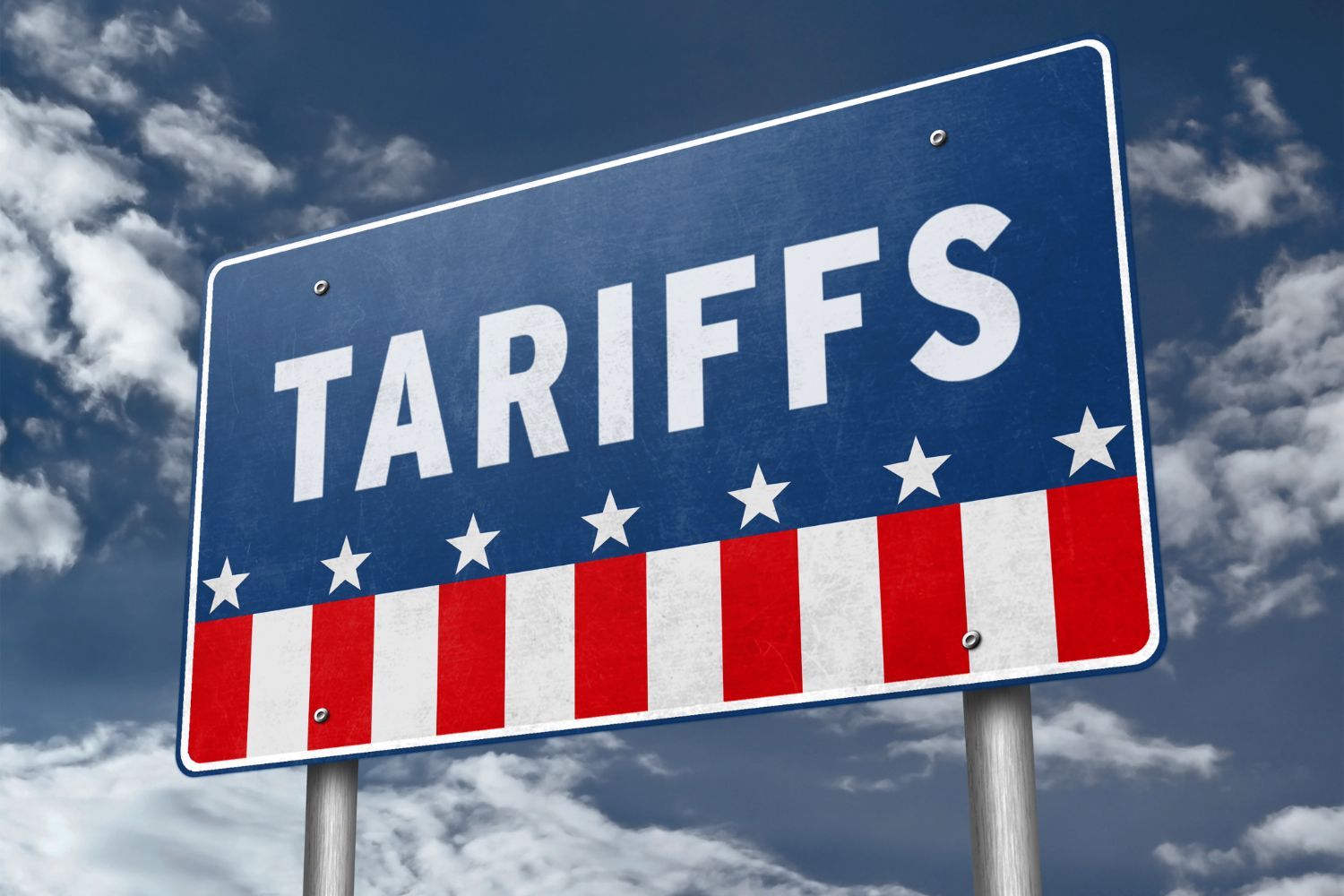
 Blackstone Minerals (BSX:AU) has announced BSX Secures JV Partner & Funding for Ta Khoa Nickel Project
Blackstone Minerals (BSX:AU) has announced BSX Secures JV Partner & Funding for Ta Khoa Nickel Project
Download the PDF here.

 Blackstone Minerals (BSX:AU) has announced BSX Secures JV Partner & Funding for Ta Khoa Nickel Project
Blackstone Minerals (BSX:AU) has announced BSX Secures JV Partner & Funding for Ta Khoa Nickel Project
Download the PDF here.

 Greenvale Energy (GRV:AU) has announced Strong Start to Maiden Drill Program at Oasis
Greenvale Energy (GRV:AU) has announced Strong Start to Maiden Drill Program at Oasis
Download the PDF here.

President Donald Trump is pushing a new economic strategy: having the U.S. government take direct stakes in major U.S. companies. He argues it’s a way to make the country stronger by shoring up industries that fuel prosperity and safeguard national security.
The first big example came last week, when the White House announced the government now owns nearly 10% of Intel. The California-based chipmaker had received federal grants to boost U.S. production, but those funds have now been converted into a formal ownership share.
The U.S. government has historically offered loans, tax breaks, or contracts to private companies — but owning stock in them is much less common, raising questions about how far Trump’s approach might go and how Intel’s competitors may view the move.
One of those competitors, SkyWater Technology, a Minnesota-based semiconductor foundry with deep ties to the defense sector, welcomed the precedent while underscoring its all-American footprint.
‘We view equity stakes as an important tool to ensure accountability when taxpayer dollars support companies whose global structures raise questions about long-term U.S. benefit,’ Ross Miller, SVP of Commercial and A&D Business, told Fox News Digital.
He contrasted that with SkyWater’s position as a fully domestic manufacturer: ‘SkyWater is different — we are U.S.-headquartered and U.S.-operated, with no foreign ownership or entanglements.’
‘Every dollar invested here directly strengthens America’s infrastructure, workforce, and independence,’ Miller added.
Looking ahead, he said SkyWater hopes to deepen collaboration with the Trump administration to expand domestic capacity in foundational chip technologies — the tried-and-true manufacturing methods that still power reliable systems in airplanes, automobiles, defense, biomedical equipment and even quantum computing.
SkyWater isn’t the only U.S. chipmaker that could be affected by Trump’s new approach. New York-based GlobalFoundries, a semiconductor manufacturer, operates large-scale chip fabs in New York and Vermont. Supported by federal funding, these sites play a central role in U.S. efforts to bring back more domestic chip production.
Given the firm’s federally-backed fabs on U.S. soil, GlobalFoundries could become a candidate for equity-linked deals tied to Trump’s semiconductor resilience goals.
Similarly, Micron Technology, which is investing tens of billions of dollars to build memory chip fabs in New York and Idaho with the support of CHIPS Act funding, could also fall under consideration. The Boise, Idaho-based company has positioned itself as a cornerstone of U.S. efforts to restore leadership in advanced memory manufacturing.
GlobalFoundries and Micron did not immediately respond to Fox News Digital’s request for comment.
On Monday, Trump suggested this was just the beginning. ‘I hope I’m going to have many more cases like it,’ he told reporters at the White House, hinting that his administration could pursue similar deals in other sectors.
But not everyone sees the move as positive.
‘This is bad policy and the most glaring example to date of the administration’s tilt towards socialism. It’s an unprecedented move, so I’m hesitant to make any predictions,’ explained Jai Kedia, a research fellow at the Cato Institute’s Center for Monetary and Financial Alternatives.
Kedia also warned the policy could display ‘favoritism towards large firms that can negotiate deals with the executive at the expense of small and mid-size firms that do not have the political clout to arrange such deals.’


Westport Fuel Systems Inc. (‘Westport’ or the ‘Company’) (TSX: WPRT Nasdaq: WPRT) today announced the resignation of its Chief Financial Officer (CFO), William Larkin and the appointment of Elizabeth Owens as his successor. Mr. Larkin will step down in his capacity as CFO effective immediately and remain in an advisory capacity through September 15, 2025, to ensure a smooth transition and the seamless transfer of duties and responsibilities.
‘On behalf of myself and the Board, I would like to thank Bill for his commitment and significant contributions to Westport,’ said Dan Sceli, Chief Executive Officer of Westport. ‘Over his time at Westport, Bill has led the organization through a transformational period, including the recent sale of the Light-Duty segment and close of our HPDI joint venture, Cespira, helping to position the organization for long-term success. Bill has been a valuable member of our management team, and we wish him well in the future.’
‘I am incredibly proud of what we have accomplished over my time at Westport to reposition the company and support its long-term strategy. As I step down from my role, I am confident Elizabeth is the right finance leader to continue building on this momentum. With strong financial expertise and a proven track record within Westport, Elizabeth brings the experience and perspective Westport needs for its next chapter,’ said Bill Larkin.
Succeeding William Larkin is Elizabeth Owens, a seasoned finance executive with experience that spans a diverse set of multinational corporate environments in a range of large publicly held companies. Ms. Owens has been with Westport for 10 years, most recently as Vice President, Finance and Tax. Over the last 20 years, Ms. Owens has held management and leadership roles across various industries, including automotive, telecommunications, aviation, and chemical manufacturing. She brings extensive experience in leading global teams in tax, finance, and accounting, as well as broad experience in mergers, acquisitions and divestitures. She began her career as a CPA, CA with Deloitte and holds a Bachelor of Commerce with a major in Accounting from the University of British Columbia.
‘Elizabeth has been a key part of our finance team for 10 years. Her expertise was instrumental in the successful execution of a number of the Company’s transformational initiatives, including the establishment of our joint venture relationship with a major OEM. We look forward to supporting her as she takes on this expanded role,’ continued Dan Sceli.
About Westport Fuel Systems
Westport is a technology and innovation company connecting synergistic technologies to power a cleaner tomorrow. As a leading supplier of affordable, alternative fuel, low-emissions transportation technologies, we design, manufacture, and supply advanced components and systems that enable the transition from traditional fuels to cleaner energy solutions.
Our proven technologies support a wide range of clean fuels – including natural gas, renewable natural gas, and hydrogen – empowering OEMs and commercial transportation industries to meet performance demands, regulatory requirements, and climate targets in a cost-effective way. With decades of expertise and a commitment to engineering excellence, Westport is helping our partners achieve sustainability goals—without compromising performance or cost-efficiency – making clean, scalable transport solutions a reality.
Westport Fuel Systems is headquartered in Vancouver, Canada. For more information, visit www.westport.com .
For more information contact:
Investor Relations
T: +1 604-718-2046
E: invest@Westport.com

![]()
News Provided by GlobeNewswire via QuoteMedia


Ottawa’s push to strengthen trade links with Europe is moving ahead on two tracks: investing in new port infrastructure at home and formalizing a minerals partnership with Germany abroad.
Speaking alongside German Chancellor Friedrich Merz in Berlin, Prime Minister Mark Carney confirmed Tuesday (August 26) that Canada would support major new infrastructure projects, including a new port in Churchill and an expansion of Montreal’s Contrecœur terminal.
He also shared a bilateral agreement with Germany to cooperate on critical minerals development which will bring the two countries working together on project financing, technological development and supply-chain integration.
“A number of those investments, the first of which we will be formally announcing in the next two weeks, are with respect to new port infrastructure,” Carney said.
The new facilities, he added, would reinforce Montreal’s port system and create “enormous LNG plus other opportunities” in Churchill, alongside upgrades to other East Coast ports to handle critical metals and minerals.
The announcements deliver on a central campaign promise by Mr. Carney’s Liberals to advance large-scale infrastructure projects as a counterweight to US President Donald Trump’s protectionist trade policies.
Natural Resources Minister Tim Hodgson signed the minerals agreement with his German counterpart in Berlin.
While not legally binding, the deal outlines plans to coordinate investment and appoint envoys to deepen cooperation in sectors ranging from electric vehicles to aerospace and defence.
“So there is a lot happening,” Carney added. “The number one focus of this government is to build that infrastructure, and particularly infrastructure that helps us deepen our partnership with our European partners, and particularly Germany.”
Germany is Canada’s largest European trading partner, with bilateral trade in goods reaching US$30.5 billion last year. For Berlin, diversifying supplies of energy and industrial inputs remains a priority after the country cut reliance on Russian natural gas following Moscow’s invasion of Ukraine.
Ottawa and Berlin have previously signed memorandums of understanding on hydrogen and critical minerals, including 2022 agreements with Volkswagen (OTC Pink:VLKAF,FWB:VOW) and Mercedes-Benz Group (OTC Pink:MBGAF,ETR:MBG) to secure supplies of nickel, cobalt and lithium for electric vehicle batteries.
Canada’s economy has long depended on the US market, and the intensifying trade dispute with Washington has accelerated Ottawa’s drive to find new outlets.
The Prime Minister has framed Europe as Canada’s most reliable alternative, calling the country “the most European of non-European nations.”
His current trip marks his fourth visit to the continent since taking office in March, with stops in Ukraine, Poland, Germany and Latvia.
For Churchill, a new port would be a welcome transformation.
The northern Manitoba town’s existing facilities have largely been used for grain exports. Expanding its capacity to handle liquefied natural gas and minerals could give Canada another strategic outlet to Atlantic markets, bypassing congested southern corridors and reducing dependence on US ports.
While Canada seeks to deepen European ties, Washington is reinforcing its own approach.
On Monday (August 25), the US Department of the Interior released a draft 2025 list of 54 critical minerals deemed vital to the economy and national security.
For the first time, copper, silver and potash were included, alongside silicon, rhenium and lead.
“President Trump has made clear that strengthening America’s economic and national security means securing the resources that fuel our way of life,” Interior Secretary Doug Burgum said in a recent press release.
“This draft list of critical minerals provides a clear, science-based roadmap to reduce our dependence on foreign adversaries, expand domestic production and unleash American innovation.”
The list, updated every three years under the Energy Act of 2020, guides federal investment, permitting, and recycling strategies. It originated with a 2017 executive order that directed agencies to assess US vulnerabilities in mineral supply chains.
The US Geological Survey tested more than 1,200 disruption scenarios for 84 minerals across 402 industries. The analysis flagged rare earths such as dysprosium, terbium and lutetium among the commodities posing the highest potential risks.
Securities Disclosure: I, Giann Liguid, hold no direct investment interest in any company mentioned in this article.

President Donald Trump is pushing a new economic strategy: having the U.S. government take direct stakes in major U.S. companies. He argues it’s a way to make the country stronger by shoring up industries that fuel prosperity and safeguard national security.
The first big example came last week, when the White House announced the government now owns nearly 10% of Intel. The California-based chipmaker had received federal grants to boost U.S. production, but those funds have now been converted into a formal ownership share.
The U.S. government has historically offered loans, tax breaks, or contracts to private companies — but owning stock in them is much less common, raising questions about how far Trump’s approach might go and how Intel’s competitors may view the move.
One of those competitors, SkyWater Technology, a Minnesota-based semiconductor foundry with deep ties to the defense sector, welcomed the precedent while underscoring its all-American footprint.
‘We view equity stakes as an important tool to ensure accountability when taxpayer dollars support companies whose global structures raise questions about long-term U.S. benefit,’ Ross Miller, SVP of Commercial and A&D Business, told Fox News Digital.
He contrasted that with SkyWater’s position as a fully domestic manufacturer: ‘SkyWater is different — we are U.S.-headquartered and U.S.-operated, with no foreign ownership or entanglements.’
‘Every dollar invested here directly strengthens America’s infrastructure, workforce, and independence,’ Miller added.
Looking ahead, he said SkyWater hopes to deepen collaboration with the Trump administration to expand domestic capacity in foundational chip technologies — the tried-and-true manufacturing methods that still power reliable systems in airplanes, automobiles, defense, biomedical equipment and even quantum computing.
SkyWater isn’t the only U.S. chipmaker that could be affected by Trump’s new approach. New York-based GlobalFoundries, a semiconductor manufacturer, operates large-scale chip fabs in New York and Vermont. Supported by federal funding, these sites play a central role in U.S. efforts to bring back more domestic chip production.
Given the firm’s federally-backed fabs on U.S. soil, GlobalFoundries could become a candidate for equity-linked deals tied to Trump’s semiconductor resilience goals.
Similarly, Micron Technology, which is investing tens of billions of dollars to build memory chip fabs in New York and Idaho with the support of CHIPS Act funding, could also fall under consideration. The Boise, Idaho-based company has positioned itself as a cornerstone of U.S. efforts to restore leadership in advanced memory manufacturing.
GlobalFoundries and Micron did not immediately respond to Fox News Digital’s request for comment.
On Monday, Trump suggested this was just the beginning. ‘I hope I’m going to have many more cases like it,’ he told reporters at the White House, hinting that his administration could pursue similar deals in other sectors.
But not everyone sees the move as positive.
‘This is bad policy and the most glaring example to date of the administration’s tilt towards socialism. It’s an unprecedented move, so I’m hesitant to make any predictions,’ explained Jai Kedia, a research fellow at the Cato Institute’s Center for Monetary and Financial Alternatives.
Kedia also warned the policy could display ‘favoritism towards large firms that can negotiate deals with the executive at the expense of small and mid-size firms that do not have the political clout to arrange such deals.’


Canada is shepherding its defense sector into a new era of higher spending and strategic importance, a policy shift that RBC (TSX:RY,NYSE:RY) analysts have called one of the most ambitious in the country’s modern history.
At the NATO summit this past June, Canadian Prime Minister Mark Carney pledged a two stage spending surge that will allow the nation to spend at least 2 percent of GDP on defense, meeting a directive from the alliance.
For Canada, that will amount to a cash increase of over C$9 billion, raising the country’s total defense-related spending to 5 percent of GDP by 2035, an annual expenditure of up to C$150 billion.
During a Monday (August 26) visit to Poland, Carney said Canada is committed to following Poland’s lead in meeting NATO defense commitments, noting Warsaw’s spending of nearly 5 percent of GDP as a benchmark.
“We learned much from the prime minister … including the importance of pulling our full weight in NATO,” he said, underscoring Canada’s goal of reaching NATO’s 2 percent target by 2026 and hitting a 5 percent security spend by 2035.
The prime minister also emphasized that this shift signals a change in Canada’s approach that will see the country contribute assertively to its own and allied security amid growing geopolitical uncertainty.
Globally, defense spending is on the rise, projected by MarketsandMarkets to reach US$2.55 billion by 2028, presenting a significant opportunity for investors interested in defense-related investments.
Canada has long lagged behind its NATO peers in terms of defense spending. According to a May report published by CIBC, Canada allocated only 1.4 percent of its GDP to defense in 2024.
Carney’s new commitments, which allocate 3.5 percent for core military spending and 1.5 percent for broader security investments like critical infrastructure, mark a stark contrast. The 2025/2026 plan from Department of National Defense and the Canadian Armed Forces underscores how this funding will be deployed, outlining a heightened focus on the Arctic and modernization of the North American Aerospace Defense Command (NORAD).
The plan also prioritizes safeguarding Canada’s defense assets, enhancing allied interoperability and integrating advanced technologies like artificial intelligence, nuclear deterrence and drones into training.
To address vulnerabilities such as transportation and manufacturing disruptions, Ottawa will develop a Defense Industrial Strategy aimed at securing timely access to key capabilities while reinforcing the domestic industrial base.
Ottawa is also planning a standalone Canadian Defense Procurement Agency, overseen by Stephen Fuhr, secretary of state for defense procurement, to deliver on these commitments.
For domestic contractors frustrated by bureaucracy and delays, these developments could be a game changer.
The RBC and CIBC reports both indicate that defense spending has a positive economic multiplier.
RBC analysts suggest that new Canadian spending commitments that prioritize major equipment purchases could change the breakdown of the nation’s defense budget, which typically allocates 50 percent to personnel, 25 percent to operations, 20 percent to capital and 5 percent to infrastructure. As per NATO’s guidelines for members, at least 20 percent of countries’ defense spending must go toward new equipment purchases.
For its part, CIBC suggests the benefits could be “larger than perceived,” with “multiple short-and long-term positive spinoffs,” including job creation, refuting the idea that defense spending “crowds out” other economic activity.
CIBC highlights defense-related research and development (R&D) as the most powerful driver of long-term economic growth in its reports, with the potential to double the economic benefit of initial spending.
Mehrdad Hariri of the Canadian Science Policy Center has also made a case for R&D spending, arguing for at least a 20 percent allocation of the defense budget, citing dual-use technologies as a catalyst for growing the broader economy.
Dual-use capabilities can also be a bridge for investors with ESG or pension constraints that avoid pure defense stocks.
RBC’s report identifies key sectors to watch in Canada’s defense market. Air, land and marine systems are listed as the country’s “core domains” of defense production, supported by strong manufacturing bases in Ontario and Québec for things like combat vehicles, aircraft fabrication, naval shipbuilding and maintenance.
Carney’s pledge to prioritize domestic suppliers is a clear signal to the Canadian defense industrial base, with industry observers linking strategic priorities to concrete market opportunities. As the Globe and Mail’s Pippa Norma has reported, Ottawa’s spending surge is set to help position homegrown players like CAE (TSX:CAE,NYSE:CAE), Calian Group (TSX:CGY), Bombardier (TSX:BBD.A,TSX:BBD.B) and Seaspan to capture new contracts.
In the shipbuilding sector, Ontario’s C$215 million initiative aims to revitalize the province’s warship industry by boosting its shipbuilding capacity for the National Shipbuilding Strategy, an industry dormant since WWII.
Ontario Premier Doug Ford and Vic Fedeli, the province’s minister of economic development, job creation and trade, recently met with senior executives of Algoma Steel Group (TSX:ASTL,NASDAQ:ASTL) to discuss the company supplying steel for the defense industry, potentially securing multibillion-dollar contracts for Canadian navy corvettes designed by Italy’s Fincantieri (BIT:FCT), one of the world’s leading shipbuilders.
“We let them know that if they try to pivot…we would be there to help them,” Fedeli told the Globe and Mail.
Another Canadian firm, Davie Shipbuilding, plans to leverage its recent acquisition of two Texas shipyards to develop local shipbuilding capacity to secure a contract to build icebreakers for the US.
The federal government is also actively pursuing partnerships. The EU defense pact, which Canada signed in June, opens a new market beyond the established US-integrated supply chains. As a recent example, Canadian armored-vehicle maker Roshel has partnered with Swedish steel producer Swebor to manufacture ballistic-grade steel in Canada.
“This project goes beyond steel — it is about establishing industrial sovereignty. By bringing ballistic steel production to Canada, we are reducing a critical dependency, protecting our supply chain, and laying the groundwork for long-term resilience in the defense and manufacturing sectors,’ said Roshel CEO Roman Shimonov in a press release.
This news comes as Canada reviews the purchase of 88 F-35 Lightning fighter jets from US defense contractor Lockheed Martin (NYSE:LMT). Carney ordered the review in March, saying Canada is overreliant on the US defense industry.
While no final decision has been made, the most likely alternative to the F-35 would be the Saab Gripen, a Swedish-made fighter jet. Mélanie Joly, Canada’s minister of innovation, science and industry, visited Saab facilities during a mid-August trip to Sweden and Finland to discuss industrial defense ties between Europe and Canada, but said it was a “normal” part of her job and that she will also meet with US executives from Lockheed Martin.
While the investment potential of Canada’s defense sector is clear, execution challenges remain. Coverage from the Globe and Mail’s Norma highlights that sentiment among executives is both wary and optimistic.
Canada’s procurement system has a long history of delays and cost overruns, and scaling up production capacity, especially outside US-integrated supply chains, will take time.
Smaller firms warn that slow procurement cycles can threaten their survival, while larger players see clear opportunities in space systems, advanced training and construction for aircraft and naval vessels.
However, RBC analysts warn that funding via higher taxes or debt could dilute the economic benefit, particularly if spending displaces other high-multiplier programs.
The ‘Buy Canadian’ directive could offer a rare moment for investors to position themselves early in a sector poised to be reshaped by unprecedented spending and technological advancement.
The sheer scale of the commitment signals a transformative period.
If effectively implemented, Carney’s plan could ignite a multi-decade boom in Canada’s defense sector, expanding opportunities well beyond traditional defense stocks and into aerospace, cybersecurity and dual-use technologies.
However, as Michael M. Smith, COO at Canadian venture capital firm ONE9, wrote for the Windsor Star:
“A new mandate alone will not transform the system if those executing it remain tethered to the same institutional caution. True reform will require individuals willing to challenge orthodoxy even when it carries political cost, those who will reject legacy processes and bloated vendor ecosystems in favour of speed, survivability, and sovereign capability.”
While the pathway may present hurdles, the foundational policy and capital are in place for a dynamic new era in Canadian defense.
Securities Disclosure: I, Meagen Seatter, hold no direct investment interest in any company mentioned in this article.

Nearly two dozen Republican state attorneys general sent a letter to Environmental Protection Agency chief Lee Zeldin Tuesday, calling on him to cancel funding to a left-wing environmental group accused of training and lobbying judges on climate policy, Fox News Digital exclusively learned.
‘As attorney general, I refuse to stand by while Americans’ tax dollars fund radical environmental training for judges across the country,’ Montana Attorney General Austin Knudsen told Fox News Digital of his push to encourage the EPA to end its funding of the Climate Judiciary Project.
‘The Environmental Law Institute’s Climate Judiciary Project is using woke climate propaganda, under the guise of what they call ‘neutral’ education, to persuade judges and push their wildly unpopular agenda through the court system,’ he said. ‘I commend President Trump’s efforts to cut waste and abuse during the first eight months of his presidency, and I am optimistic that his Administration will do the right thing and halt all funding to ELI.’
Knudsen spearheaded the letter sent to Zeldin Tuesday, which included the signatures of 22 other Republican state attorneys general, calling for the EPA to axe its funding to the left-wing environmental nonprofit, called the Environmental Law Institute, which oversees the Climate Judiciary Project (CJP).
The Environmental Law Institute founded the Climate Judiciary Project in 2018, which pitches itself as a ‘first-of-its-kind effort’ that ‘provides judges with authoritative, objective, and trusted education on climate science, the impacts of climate change, and the ways climate science is arising in the law.’
The group, however, has been accused of trying to manipulate judges to make them more amenable to left-wing climate litigation.
The letter sent Tuesday called on the EPA specifically to end any grants and awards endowed to the group.
‘We write to bring to your attention grants made by EPA to the Environmental Law Institute (‘ELI’),’ the letter reads. ‘According to its 2024 financial statements, ELI received approximately 13% of its revenue in 2023, and 8.4% in 2024, from EPA awards. ELI also apparently still expected to receive funds from the federal government; its financial statement warned that the collectability of federal grant funds ‘is subject to significant uncertainty related to collectability and continual funding due to (the federal grant) funding freeze or other federal actions.”
The Environmental Law Institute received $637,591 from the EPA in 2024 and $866,402 in 2023 from the EPA, according to nonprofit tax documents published by ProPublica detailing the group’s federal expenditures that year.
‘The Climate Judiciary Project’s mission is clear: lobby judges in order to make climate change policy through the courts,’ 23 state attorneys general wrote in the letter. ‘An alumni magazine profile said the quiet part out loud, writing that the Climate Judiciary Project co-founder was ‘explaining the science of climate change to a group of people with real power to act on it: judges.’ The Climate Judiciary Project’s tampering raises serious legal and ethical questions.’
The Environmental Law Institute, however, in a recent comment to Fox News Digital, has maintained that its educational programs through Climate Judiciary Project are in accordance with the standards established by national judicial education institutions.
Climate Judiciary Project educational events are done ‘in partnership with leading national judicial education institutions and state judicial authorities, in accordance with their accepted standards,’ a spokesperson for the group said in an emailed statement in July. ‘Its curriculum is fact-based and science-first, grounded in consensus reports and developed with a robust peer review process that meets the highest scholarly standards.’
‘CJP’s work is no different than the work of other continuing judicial education organizations that address important complex topics, including medicine, tech and neuroscience,’ an Environmental Law Institute spokesperson previously told Fox News Digital when asked about its educational programs.
The call for EPA to slash any funds to the Environmental Law Institute was celebrated by leading groups such as the American Energy Institute and the Alliance for Consumers, who lamented in a comment to Fox Digital that taxpayer funds should not be used to fund the group and that ‘courtroom maneuvering’ threatens day-to-day life.
‘The State Attorneys General are right to call for the elimination of taxpayer funding for the Environmental Law Institute and its Climate Judiciary Project,’ Jason Isaac, CEO of the American Energy Institute, told Fox Digital. ‘This is a coordinated campaign to advance the Green New Deal through the judiciary using so-called climate litigation in the courts. Its curriculum is developed by climate alarmist allies of the plaintiffs and delivered to judges behind closed doors. Public funds should never be used to finance political advocacy disguised as judicial education.’
O.H. Skinner, the executive director of Alliance for Consumers, which is a nonprofit focused on advocating on behalf of American consumers, remarked that ‘as we have long warned, the left has a plan to reshape American society by using lawsuits in courts all across the country, especially in places like Hawaii and other coastal enclaves.’
‘The new wave of revelations about ELI is further concerning evidence of how committed the left is to imposing mandatory Progressive Lifestyle Choices through this courtroom maneuvering and how big a threat it really is to all our ways of life,’ Skinner added.
The Tuesday letter specifically argued: ‘State consumer protection laws prohibit deceptive and misleading statements to market a product. ELI is representing its training as objective when reality shows that it is not. State Attorneys General are responsible for protecting consumers, and we are concerned by ELI’s statements.’
The EPA has taken a hatchet to millions of dollars doled out under the Biden administration to left-wing groups and other programs deemed a waste of taxpayer funds upon Zeldin’s Senate confirmation as EPA chief in January.
The EPA under the Trump administration has canceled $20 billion in grants under the Inflation Reduction Act — which has led to an ongoing court battle. Zeldin said in March that the $20 billion in U.S. tax dollars were ‘parked at an outside financial institution in a deliberate effort to limit government oversight, doling out your money through just eight pass-through, politically connected, unqualified, and in some cases brand-new NGOs.’
The state attorneys general reflected on the previous cuts in their call to Zeldin to do the same to ELI funding.
‘Under President Trump’s bold leadership, federal agencies and the Department of Government Efficiency have saved an estimated $190 billion, including terminating more than 15,000 grants that saved approximately $44 billion,’ the letter states. ‘You have heeded President Trump’s directive and achieved monumental savings for taxpayers. You canceled $20 billion in climate grants under the Inflation Reduction Act. You canceled another $1.7 billion in diversity, equity, and inclusion grants.3 And you canceled 800 environmental justice grants.’
Climate Judiciary Project and the Environmental Law Institute previously have come under fire from lawmakers such as Republican Texas Sen. Ted Cruz, who accused the groups of working to ‘train judges’ and ‘make them agreeable to creative climate litigation tactics.’
The Texas Republican recently has argued there is a ‘systematic campaign’ launched by the Chinese Communist Party and American left-wing activists to weaponize the court systems to ‘undermine American energy dominance.’
Climate Judiciary Project is a pivotal player in the ‘lawfare’ as it works to secure ‘judicial capture,’ according to Cruz, Fox Digital has previously reported.


Tariffs have been central to Donald Trump’s presidency even before he assumed office at the start of 2025.
From his perspective, levies on nearly all US imports are meant to balance a trade deficit with major partners, including Canada, Mexico, the EU and the UK, while stimulating domestic production in key sectors.
Trump has put forward other reasons for tariffs as well, saying he wants to stem the flow of illegal drugs and immigration, and mentioning broader national security concerns. How effective tariffs would be at controlling these issues is unclear, but they have sown uncertainty and chaos through global financial markets.
In the copper sector, tariff turmoil has created price volatility and left investors wondering how to position.
On February 25, not long after taking office for the second time, Trump initiated an investigation into copper’s national security implications under Section 232 of the Trade Expansion Act of 1962.
Further details came months later, when the president provided an update on on July 8.
“I believe the tariff on copper, we’re going to make 50 percent,” Trump said during a White House cabinet meeting.
His comments came without an official announcement, although Secretary of Commerce Howard Lutnick said the tariff could take effect by late July or early August. This lack of clarity caused copper prices on the Comex to surge as traders worked to bring the metal into the US ahead of potential levies.

Copper price, January 1, 2025, to August 25, 2025.
Chart via Comex Live.
Ultimately, the Trump administration said on July 30 that copper tariffs would only be applied to unrefined copper, semi-finished and copper-intensive derivatives like pipe fittings, cables, connectors and electrical components.
Refined copper will be phased in at 15 percent in 2027 and 30 percent in 2028.
The move essentially pulled the rug out from prices and caused Comex copper to plummet nearly 25 percent.
Copper is increasingly being viewed as a critical mineral, and there are clear reasons why the US would want to increase production of the metal. But what do Trump’s tariffs really mean for supply?
Taking a look at how US steel and aluminum tariffs played out in 2018, during Trump’s first presidency, could provide insight. A March article published by Reuters analyzes the overall impact of those tariffs.
Prices started to rise in the lead up to the expected tariff deadline, similar to what happened with copper this time around, as importers began stockpiling products ahead of fee implementation. Steel prices rose 5 percent within a month of the tariffs being applied, while aluminum prices rose 10 percent. While they began to fall after just a few months, there was still a significant gap between prices for these products in the US and the rest of the world.
There were also more pronounced fluctuations between US and world prices as COVID-19 pandemic supply chain disruptions further impacted the steel and aluminum sectors.
While the steel and aluminum tariffs did stimulate domestic production of these materials, they ultimately weren’t enough to overcome the price differential, as increased US output also faced headwinds.
The US is facing these same challenges with copper production. According to the US Geological Survey, in 2024 the US produced 1.1 million metric tons of unrefined copper and 850,000 metric tons of refined products. The US also exported 320,000 metric tons of concentrates and 60,000 metric tons of refined copper.
However, US demand requires 1.8 million metric tons of refined product annually, more than double US capacity — that’s a key reason why refined products were exempted from tariffs.
“The US does not have the capacity to produce all the copper that we consume. While there have been investments in new mining capacity, these facilities will take years to come online, leaving US businesses reliant on copper imports for at least the near term.’
Although copper is classified as a critical mineral in the US, expanding existing operations will take years, and the time from discovery to opening a new mine could still take more than a decade.
One project nearing completion is Taseko Mines’ (TSX:TKO,NYSEAMERICAN:TGB) Florence property in Arizona. The company acquired the asset in 2014, but a March 2023 technical report shows exploration dates back to the 1970s. After environmental assessments, permitting and the building of a test facility between 2017 and 2020, Taseko started full-scale construction of the mine in 2024, with the expectation that operations will begin in late 2025.
Likewise, new smelting operations will not come online until after the first phase of tariffs on refined copper are added in 2027. The newest smelter in the US is Aurubis’ (OTC Pink:AIAGF) Richmond facility in Augustus, Georgia. The facility was designed to domesticate some of the more than 900,000 metric tons of scrap copper exported from the US to smelting facilities overseas each year. Construction took four years and US$800 million.
Once operational, the plant will produce 70,000 metric tons of refined copper annually, which is less than 10 percent of annual copper imports to the US.
Time isn’t the only factor hindering the expansion of US copper production.
Mining is an energy-intensive business, and as demand for electricity grows, copper smelters may have to compete with other entities, similar to what happened in the steel and aluminum sector in 2019.
An April McKinsey report suggests that US power demand will grow at a CAGR of 3.5 percent, increasing from around 4,000 terawatt hours (TWh) in 2025 to about 5,000 TWh in 2030 and 7,000 TWh by 2040.
The report states that this increased demand could lead to bottlenecks as providers are faced with supply chain issues and shortages of dispatchable power as new projects face delays due to labor shortages and multi-year lead times for necessary equipment. It also notes that retail electricity bills have increased 6 percent per year since 2020.
The alternative for the copper sector would be to incur further capital costs by investing in off-grid capacity — this might also be affected by tariffs, as has been seen with photovoltaic imports.
The Reuters report evaluating steel and aluminum tariffs notes that the fees were ultimately lifted in 2019 due to the high cost of electricity and limited demand. The downstream effects meant that the manufacturing, construction and transportation industries faced higher costs, reducing growth in those sectors.
Likewise, a small uptick of about 8,000 jobs in the steel and aluminum sectors was outweighed by losses in other industries as companies sought to offset higher costs through efficiency gains.
One study concluded that the tariffs resulted in the loss of 75,000 manufacturing jobs.
Although the bulk of copper tariffs will be phased in starting in 2027 and 2028, that may not provide enough lead time to build new operations and ensure they have the inputs they need to carry out business.
If applied incorrectly, tariffs could have significant consequences for industries that rely on the red metal, including tech and construction, while also impacting overall economic growth.
“Tariffs will increase the cost to US importers and consumers of copper and related products, and will put downside pressure on potential growth,” Saidel-Baker said.
For investors interested in copper, the long-term picture is key.
Although Trump’s scaled-back tariff announcement caused a price pullback, demand for copper is expected to significantly outweigh supply in the coming years, with experts calling for consumption from the tech industry and energy transition to add to growing requirements from urbanization in the Global South.
Whether tariffs will provide a competitive advantage for copper companies already producing and serving the US market remains to be see, but some market watchers see potential for that to happen.
For example, Morgan Stanley (NYSE:MS) upgraded its price target for Freeport-McMoRan (NYSE:FCX) to US$48 on August 11. In its reasoning, Morgan Stanley said that the market is not currently appreciating the benefits Freeport will gain from the tariffs, also noting that it will be able to raise pricing for 2026 copper rod contracts, a semi-finished product, which accounts for the majority of the company’s North American sales volume.
Robert Friedland, founder and co-chair of Ivanhoe Mines (TSX:IVN,OTCQX:IVPAF), has come out in support of the tariffs, suggesting that they will help to rebuild the US copper industry. His reasoning is based on the national security issues inherent to having a single country dominate nearly 50 percent of the market of such a critical mineral.
Tariffs apply a new layer of uncertainty to an already challenging copper supply scenario. If tariffs are phased in gradually and industry is given the proper amount of time and investment, it could lead to a resurgence in US copper production and be a boon for those projects already in development; if not, then it could be a replay of 2018.
Securities Disclosure: I, Dean Belder, hold no direct investment interest in any company mentioned in this article.


Armory Mining Corp. (CSE: ARMY) (OTC: RMRYF) (FRA: 2JS) (the ‘Company‘ or ‘Armory‘) a resource exploration company focused on the discovery and development of minerals critical to the energy, security and defense sectors, is pleased to announce the closing of its oversubscribed non-brokered private placement offering (the “Offering”), previously announced by the Company on August 7, 2025, by issuing 16,060,000 units (the “Units”) at a price of $0.05 per Unit for aggregate gross proceeds of $803,000.
Each Unit is comprised of one common share and one transferrable common share purchase warrant (a “Warrant”). Each Warrant entitles the holder to acquire an additional common share at a price of $0.065 per common share until August 25, 2028.
In connection with the Offering, the Company paid cash finder’s fees of $54,350 and issued 1,028,000 finder’s warrants to eligible arm’s length finders. The finder’s warrants are exercisable into a common share at $0.065 per common share until August 25, 2028. The Company also issued 1,300,000 common shares to an arm’s length advisor for providing the Company financial advisory, consulting, and support services in connection with the Offering.
The proceeds raised from the Offering are expected to be used for working capital and general corporate purposes. All securities issued under or in connection with the Offering are subject to a four month hold period expiring December 26, 2025, in accordance with applicable Canadian securities laws.
About Armory Mining Corp
Armory Mining Corp. is a Canadian exploration company focused on minerals critical to the energy, security and defense sectors. The Company controls an 80% interest in the Candela II lithium brine project located in the Incahuasi Salar, Salta Province, Argentina and a 100% interest in the Riley Creek antimony-gold project located in Haida Gwaii, British Columbia, and an option to acquire a 100% interest in the Ammo antimony-gold project located in Nova Scotia.
Contact Information
Alex Klenman
CEO & Director
alex@armorymining.com
Neither the Canadian Securities Exchange nor its Market Regulator (as the term is defined in the policies of the Canadian Securities Exchange) accepts responsibility for the adequacy of accuracy of this news release. This news release does not constitute an offer to sell or a solicitation of an offer to buy nor shall there be any sale of any of the Company’s securities in any jurisdiction in which such offer, solicitation or sale would be unlawful, including any of the securities in the United States of America. The Company’s securities have not been and will not be registered under the United States Securities Act of 1933, as amended (the ‘1933 Act’) or any state securities laws and may not be offered or sold within the United States or to, or for account or benefit of, U.S. Persons (as defined in Regulation S under the 1933 Act) unless registered under the 1933 Act and applicable state securities laws, or an exemption from such registration requirements is available.
Forward-looking statements:
This press release contains certain forward-looking statements, including statements regarding the intended use of funds. The words ‘expects,’ ‘anticipates,’ ‘believes,’ ‘intends,’ ‘plans,’ ‘will,’ ‘may,’ and similar expressions are intended to identify forward-looking statements. Although the Company believes that its expectations as reflected in these forward-looking statements are reasonable, such statements involve risks and uncertainties. Actual results may differ materially from those expressed or implied in these statements due to various factors, including, but not limited to, political and regulatory risks in Canada, operational and exploration risks, market conditions, and the availability of financing. Readers are cautioned not to place undue reliance on forward-looking statements, which are made as of the date of this release. The Company undertakes no obligation to publicly update or revise any forward-looking statements, whether as a result of new information, future events, or otherwise, except as required by applicable securities laws.
Source